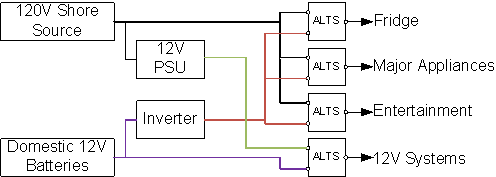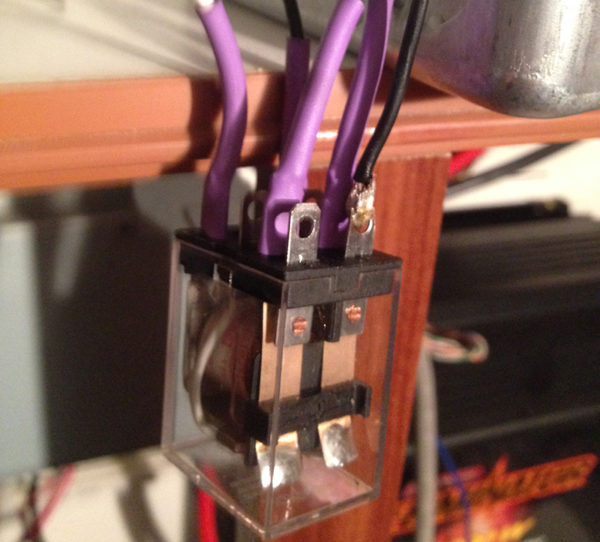In a previous post we considered how to verify we are using a safe source of shore power and where we should apply the KISS principle to that process, but there’s another big consideration – what’s the best source of power at any given time and how can we ensure that we are using it?
When building a skoolie, you can get appliances which are powered by a number of means and sources but not all are created equal. Certain power sources can significantly impact the price, usefulness, and longevity of your project.
Means of power versus sources of power
Let us differentiate means of power versus sources of power. To me, different means of power are different mechanisms for obtaining power. Common means of power in motorized homes include but are not limited to electricity and propane. Certain means of power can have a variety of sources of power. Using electricity as a means of power, you can have batteries, an alternator, a generator, solar panels, or shore power as your source of power. Frequently you’ll have multiple sources of electrical power such as an alternator to get power while the engine is running and batteries to provide power when the engine isn’t running.
In the case of Sheila, we elected to use electricity as our only means of power. We made this choice because including built-in propane appliances would have greatly impacted the project. I spoke to various insurance providers prior to making the decision and the policies varied from simply refusing to insure vehicles with built-in propane appliances to requiring professional installation and inspecting for all on-board propane systems. I can, certainly, understand the policies and don’t blame them.
Some appliances can have multiple means for powering them, there are refrigerators which use both propane and electricity, but they can also have multiple sources for powering them, your refrigerator can run off of battery or shore power.
Multiple-source appliances
Some RV-specific appliances have multi-source options built in such as a refrigerator which can run off a 12V battery system or a 120V shore system when available. If you are purchasing new appliances you may want to go for such a unit but if you already have a 120V bar fridge you’d like to use on your Skoolie, using the item you already have may cost less. Note that I said ‘may’, if you have a 120V bar fridge you want to use, you’ll have no trouble when you are parked with access to shore power but if you want to run that fridge off of battery power, you’ll need an inverter. If you already have an inverter of sufficient size, you’re all set but, if you don’t, you’ll need to figure out if purchasing a new fridge or purchasing a proper inverter is best.
RV-specific appliances may elect to go with the best source of power, but if you make use of regular appliances you may want to build your own system for using the best source. Let’s go back to the KISS principle. If we have a 120V bar fridge which we want to power off of shore power or the inverter (alternator, solar, or battery power) we could just have two outlets next to the fridge one hooked up to our shore-power-hook-up and the other hooked up to the inverter. When we are parked with access to shore power, you plug the fridge into the shore outlet, when we don’t have access to shore power, you plug the fridge into the other outlet and turn on the inverter. Simple enough implementation, but difficult execution and you can easily forget to switch which plug you are plugged in to, potentially draining scarce power sources or leaving your fridge unpowered until you notice the gaffe.
But what if we want the day-to-day power management to be governed by the KISS principle? A DPDT (Double Pole, Double Throw) relay could be used to ensure the fridge is hooked up to the shore power when it is available or hooked up to the inverter when shore power isn’t available. In this case shore power, when available, is our preferred source of power because it exists in unlimited quantities. The inverter is our backup source but is a limited source so we don’t want to squander it holding relays in a specific position. To this end, we’ll want the base state of the relay to connect the fridge to the inverter and the shore power to hold the relay such that the shore power is the source.

Please note the use of the double-pole relay. This is important as the we need to switch both the neutral and the hot between the sources while the grounds can all be hooked together. While the neutral should be at the same potential as the ground, wiring faults or defective equipment can cause different potentials to occur which could cause even larger problems if you don’t isolate the shore neutral from your inverter neutral where the inverter bonds the neutral to ground.
One could have a single ALTS (Automatic Load Transfer Switch) that controls all your appliances, an individual load transfer switch for each appliance, or some other combination, it all depends on your needs. Just make sure that your solution is designed and built to handle the maximum possible load. In the case of Sheila, we have one ALTS per domestic power bus, of which we have four.

Why four buses? Because they each have their own needs. The fridge should have power at all times. Major appliances should only be powered when we are using them and should be limited to a single appliance being used at any given time. Entertainment systems (game consoles, TV, laptops, etc) should only be powered when we are using them but, unlike appliances, we want to be able to use multiple items at once. Lights, stereo, cell phone chargers, and our water pump are all low-voltage accessories so we power them all off a 12V bus. The 12V bus can pull directly out of our domestic batteries but when shore power is available we use a 12V PSU to supply that power and give our batteries a chance to recharge.
The above diagram is simplified, as we have a battery charger which recharges the domestic batteries while we are on shore power, an alternator which recharges them while we are under way, and eventually we intend to have a solar system which will all be used to keep our domestic batteries topped up but that falls out of the scope for this post so will be included in a future post.
